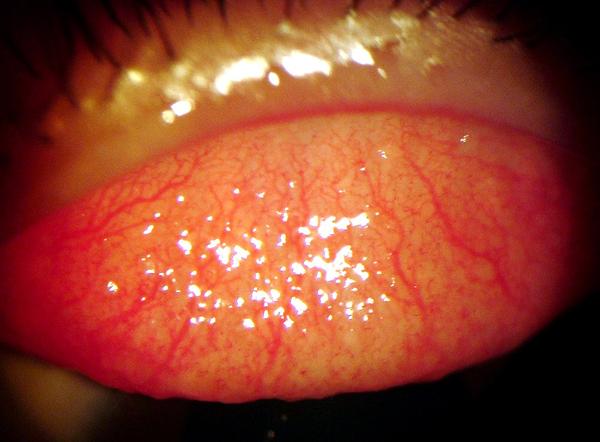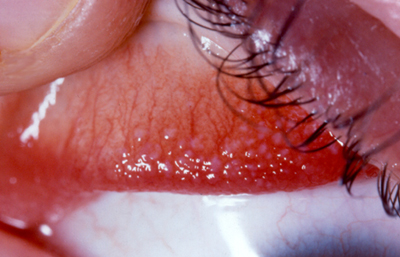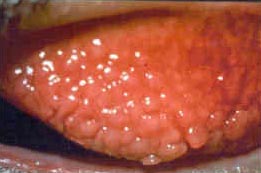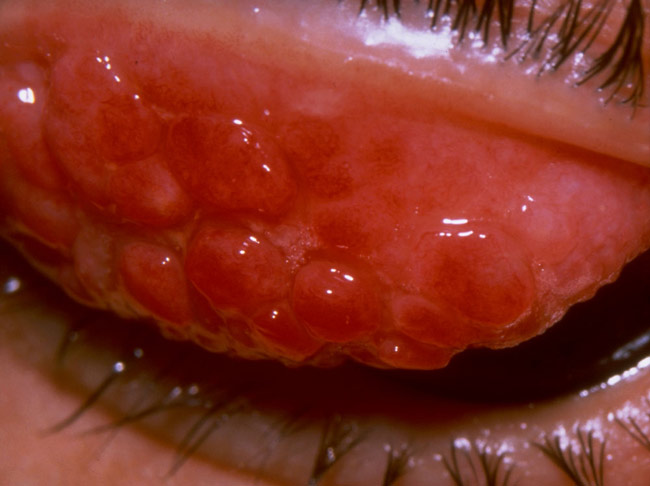WHAT CAUSES GPC?
GPC is commonly associated with wearing contact lenses that are coated or have deposits. For that reason, it is considered a relatively “new” eye condition, having first become a major concern of eye care professionals in the 1970’s. In addition to contact lens wear, GPC may result from wearing an eye prosthesis (artificial eye) or from a protruding or uncovered end of a “stitch remnant” left exposed after eye surgery.
WHAT ARE THE SYMPTOMS OF GPC?
In the mild stage, reduced contact lens wearing time is the most common symptom. Many factors can affect comfortable wearing time, such as lack of sleep, environmental irritants, or dry eyes. However, persistent loss of wearing time, in the absence of identifiable reasons, may indicate an early stage of giant papillary conjunctivitis.
Four stages of the condition have been identified and described:
Stage 1: Pre-Clinical

The patient has begun to feel discomfort when wearing contacts, but there is no obvious buildup of deposits on the contact lenses. There is a mild increase in the amount of mucus present in the morning, and mild itching occurs when lenses are removed.
Stage 2: Early Clinical

A light coating of material has been deposited on the lens and enlarged papillae are forming. Additionally, small amounts of mucus are present over the papillae. Mild redness of the eyes occurs, and there is an increase in the amount of mucus present on awakening. Itching on removal of lens becomes more severe, and the wearer is much more aware of the lens late in the day.
Stage 3: Moderate

There is a medium to heavy coating of deposit material on the lens. The number, size, and elevation of papillae increase; there is a great deal more redness and swelling of the conjunctiva. Moderate to heavy mucus is often present in the morning. Itching on removal of lens may be moderate to severe and may vary on a daily basis.
Stage 4: Severe

The severe stage is accompanied by a heavy deposit of protein on the lens. Papillae increase in size, number, and elevation. Redness, swelling, and mucus production become more severe; and some changes in the cornea may be present. Heavy mucus production is noticed on awakening and eyelids may stick together.
Preventative measures for those who wear soft lenses should include:
- Good care of your lenses: cleaning, disinfecting, and soaking with solutions recommended by your eye care professional
- Routine measures such as daily cleaning, as well as weekly cleaning of lenses with an enzymatic solution to remove protein deposits
- More frequent replacement of disposable lenses
- Change to daily disposable lenses
Preventative measures for gas-permeable lenses should include:
- All possible measures for good care of lenses, including enzymatic cleaning at intervals recommended by your doctor
- Click here for Tips on Cleaning
TREATMENT:
Giant papillary conjunctivitis can be difficult to treat. Discontinuing lens wear is usually required to treat patients who are in stage 3 or 4. Also, the instillation of anti-inflammatory eye drops helps to speed recovery. Decreased wearing time, more frequent lens replacement, or a diligent cleaning routine may be all that is necessary to improve the condition at earlier stages.
The most effective, easiest treatment of giant papillary conjunctivitis is simply to discontinue contact lens wear. When the patient ceases wearing lenses, the symptoms usually disappear with time, which varies from weeks to months.
Of course, many contact lens wearers find this an unacceptable solution. It may become more palatable if they understand it need not be forever. If the eyes are given an opportunity to recover, contact lens wear may be possible at a later time. However, even after a break, the problem may recur when lens wear is resumed.
GIANT PAPILLARY CONJUNCTIVITIS IS EASIER TO PREVENT THAN CURE
Even though we do not know exactly what causes giant papillary conjunctivitis, we do know that protein deposits are likely a contributing factor, so meticulous attention to cleaning is important. In addition, a well-fitted pair of contact lenses is essential to prevent problems such as giant papillary conjunctivitis.
REMEMBER…
Giant papillary conjunctivitis is treatable, and there are many options to explore before giving up on contact lenses. Working together, we can explore alternatives for care and develop a plan for continuous clear and comfortable vision.
Proclear soft contact lenses (CooperVision) are one popular option. Proclear lenses are made of a high-water hydrogel material and feature CooperVision’s trademarked “PC Technology” whereby the lenses contain molecules found naturally in human cell membranes. These molecules attract and surround themselves with water, keeping Proclear lenses moist and comfortable, even after 12 hours of wear, according to the company.
Proclear-brand contact lenses are currently the only contacts approved by the U.S. FDA to carry this label: “May provide improved comfort for contact lens wearers who experience mild discomfort or symptoms relating to dryness during lens wear.” Proclear lenses are available in a variety of designs, including a daily disposable version.
Extreme H2O (Hydrogel Vision) is another brand of soft lenses that many ECPs report is useful in solving dryness-related comfort issues. Extreme H2O lenses are made of two high-water hydrogel materials that have unique water-binding properties that allow the lenses to retain virtually all their water content through the entire wearing period, according to the company. Extreme H2O lenses are available in weekly and two-week disposable designs.
Another option is Ultra disposable contact lenses (Bausch + Lomb). These silicone hydrogel lenses feature MoistureSeal technology that provides unsurpassed comfort and vision all day compared with the leading silicone hydrogel lenses, according to Bausch + Lomb. MoistureSeal technology enables Ultra lenses to retain moisture for up to 16 hours, the company says.
Still another option that many eye doctors are recommending for contact lens wearers with dryness problems are Daily Disposable lenses. These single-use lenses feature an innovative water gradient design: the water content is approximately 33 percent at the core of the lens and increases to greater than 80 percent at the front and back surface. Because of this gradient design, Daily Contact Lenses provide “a silky-smooth surface for comfort that lasts until the end of the day,” according to the company.
Topical steroids can be used in the treatment of giant papillary conjunctivitis but are not necessary in all cases. Contact lens hygiene is an important component in the disease’s deterrence.
